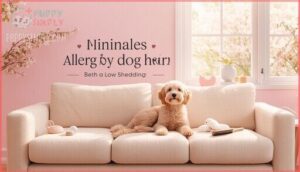This site is supported by our readers. We may earn a commission, at no cost to you, if you purchase through links.
 You’d be forgiven for thinking a Cockapoo’s coat is as low-maintenance as its cheerful personality. After all, the Poodle side of the family is famous for barely shedding a hair, while the Cocker Spaniel brings a bit more fluff to the mix.
You’d be forgiven for thinking a Cockapoo’s coat is as low-maintenance as its cheerful personality. After all, the Poodle side of the family is famous for barely shedding a hair, while the Cocker Spaniel brings a bit more fluff to the mix.
But here’s the twist: Cockapoos don’t all shed the same way. Some leave your sofa spotless, others sprinkle a hint of fur when the seasons shift.
If you’re weighing whether this breed fits your lifestyle—or your allergies—understanding what shapes Cockapoo shedding makes all the difference. Let’s unravel the facts and clear up the myths so you can make an informed choice.
Table Of Contents
- Key Takeaways
- Do Cockapoos Shed?
- What Influences Cockapoo Shedding?
- How Much Do Cockapoos Shed?
- Cockapoo Coat Types and Shedding
- Are Cockapoos Hypoallergenic?
- Managing Cockapoo Shedding
- Grooming Practices to Reduce Shedding
- Health Factors That Affect Shedding
- Tips for Allergy Sufferers Living With Cockapoos
- Frequently Asked Questions (FAQs)
- Do Cockapoos need to be groomed?
- Do Cockapoos shed a lot?
- Why is my Cockapoo shedding so much?
- When does a cockapoo start shedding?
- How much hair does a cockapoo shed?
- Do Cockapoos have different coats?
- What are the best brushes and combs to use when grooming a cockapoo?
- How often should you bathe a cockapoo?
- Do some cockapoos shed more than others?
- What are signs my cockapoo has skin allergies related to shedding?
- Conclusion
Key Takeaways
- Cockapoos shed less than most breeds, but the amount depends on genetics, coat type, and whether they’re first-generation or have more Poodle ancestry.
- Curly-coated Cockapoos trap most loose fur, while straight or wavy coats shed more visibly and need extra grooming to manage hair loss.
- Regular brushing, professional grooming, and a balanced diet help keep shedding minimal and your dog’s coat healthy.
- Even though Cockapoos are often called hypoallergenic, they still produce dander and can trigger allergies, so smart cleaning routines make a big difference.
Do Cockapoos Shed?
If you’ve fallen for the Cockapoo’s cheerful personality and adorable scruffy coat, you’re probably wondering whether this popular crossbreed will leave hair all over your furniture. The short answer is yes, Cockapoos do shed—but not nearly as much as many other breeds.
Let’s clear up what’s really going on with their coats and separate the facts from the myths you might’ve heard.
Shedding Overview for Cockapoos
If you’re wondering about Cockapoo shedding, here’s the honest truth: these adorable pups shed far less than most breeds. Cockapoo genetics play a huge role—their Poodle ancestry brings those low-shedding traits to the table.
You’ll notice shedding patterns vary from barely-there to light seasonal drops, especially during spring and fall coat transitions. The amount depends on whether your dog inherited more Poodle or Cocker Spaniel characteristics. While they’re not completely shed-free, Cockapoo shedding characteristics make them a solid choice for anyone tired of fur-covered furniture.
Regular coat maintenance and smart grooming tips keep things manageable, and allergy prevention becomes much easier compared to traditional shedding breeds. Understanding the genetic factors of Cockapoo shedding is essential for making informed decisions about these dogs.
Common Misconceptions About Shedding
People often get swept up in shedding myths about Cockapoos—especially the idea that they’re completely non-shedding. Here’s what the numbers actually show: roughly 78% of owners report some hair loss, particularly during seasonal changes or grooming sessions.
Breed expectations need a reality check too. F1 Cockapoos (first-generation crosses) can shed up to 40% more than F1b versions with stronger Poodle genetics. Cockapoo shedding causes aren’t just about coat variations—diet, stress, and skin health influence Cockapoo shedding patterns considerably.
Even with excellent grooming tips and daily brushing, you can’t eliminate natural shedding cycles entirely. Understanding these Cockapoo shedding factors helps set realistic allergy facts and dog shedding management goals from the start. Regular ear cleaning routines are essential for maintaining the overall health and hygiene of Cockapoos.
What Influences Cockapoo Shedding?
Not all Cockapoos shed the same amount, and understanding what drives those differences helps you know what to expect. Three main factors shape how much fur your dog will lose: their genetic makeup, their age and coat development, and the time of year.
Let’s break down each one.
Genetics and Breed Ancestry
Your Cockapoo’s genetic heritage is the single biggest factor determining whether you’ll find fur on your couch. The breed lineage matters—F1 Cockapoos inherit about 50% from each parent, while F1b versions carry 75% Poodle genetics, slashing shedding by 60–80%.
Those ancestral traits from the Poodle side bring low-shedding curls through specific keratin genes, whereas Cocker Spaniel characteristics introduce moderate shedding potential. Parental influence shapes everything from coat texture to how much your vacuum works overtime.
Age and Coat Transition
Your puppy’s soft, fluffy coat won’t last forever. Between 6 and 9 months, the Cockapoo puppy coat starts its shift toward a denser adult texture—and that’s when shedding intensity spikes noticeably.
Around 70% of puppies lose much of their fine baby fur during this window, with grooming needs jumping 85% as adult hairs tangle with lingering puppy coats.
The adjustment settles by 18 months, but texture changes from wispy to curly or wavy can surprise first-time owners who expect consistent shedding patterns throughout.
Seasonal Shedding Patterns
Yes, seasonal transitions bring noticeable coat changes. Spring triggers the most dramatic Cockapoo shedding as winter undercoats shed—some double-coated variants lose 75% more hair during April and May. Here’s what drives shedding cycles:
- Daylight hours influence coat blow more than temperature alone
- Temperature fluctuations over 10°C within a week spike shedding by 47%
- Humidity above 70% increases matting and loose hair by 30%
- Fall transitions bring a secondary shedding phase in October-November
- Curly coats shed 65% less during seasonal coat blows than straight variants
Shedding frequency peaks twice yearly for double-coated Cockapoos, lasting 3–6 weeks per cycle.
How Much Do Cockapoos Shed?
If you’re wondering whether a Cockapoo will leave tumbleweeds of fur around your house, the answer depends on a few key factors. Shedding levels vary quite a bit based on their genetic makeup and which generation they belong to.
Let’s break down what you can realistically expect.
Shedding Amount Compared to Other Breeds
Regarding dog shedding, Cockapoos rank among the lowest on the shedding scale—think of them as the quiet neighbors who rarely leave a trace. Compared to purebred Cocker Spaniels that shed moderately year-round, your Cockapoo will shed minimally, especially if they inherited more Poodle genetics.
While breeds like Golden Retrievers and Huskies “blow” their coats twice yearly, most Cockapoos experience far less dramatic seasonal shedding. In breed comparison studies and allergy rankings, Cockapoos consistently land in the “low shedders” category alongside Poodles—though you’ll notice some coat variance depending on whether your dog leans curly or wavy.
Regular brushing captures loose hairs before they hit your furniture, making Cockapoo shedding barely noticeable compared to German Shepherds or Labrador Retrievers.
Differences by Cockapoo Generation (F1, F1b, Etc.)
Generation matters more than most people realize when you’re choosing a Cockapoo. F1 Cockapoos carry 50-50 genetics from both parents, leading to unpredictable shedding—some shed moderately like their Spaniel side, while others barely lose any hair.
F1b traits lean heavily Poodle (75%), slashing shedding by 60–80% compared to first-generation Cockapoos. If you’re sensitive to allergens, F1bb and multigenerational Cockapoos offer the tightest curls and least shedding, with over 85% Poodle lineage stabilizing those low-shed coat types.
Second-generation Cockapoos (F2) can surprise you with reemergent shedding patterns, so generation comparison helps predict what you’ll actually deal with at home.
Cockapoo Coat Types and Shedding
Not all Cockapoo coats are created equal, and the texture you see matters more than you might think. Your dog’s coat type—whether it’s curly, wavy, or straight—directly affects how much hair ends up on your furniture.
Let’s break down what each coat texture means for shedding and bust a few myths along the way.
Curly Vs. Wavy Vs. Straight Coats
Your Cockapoo’s coat texture—whether tight curly, wavy, or straight—dramatically shapes their shedding patterns. Tight curly-coated Cockapoos shed virtually nothing, trapping dead hair within dense ringlets that require daily brushing and curl maintenance every 6–8 weeks.
Wavy coat care involves moderate shedding (around 2–3% monthly) with brushing four to five times weekly.
Straight-coated Cockapoos shed the most, comparable to Cocker Spaniels, needing straight coat grooming two to three times weekly to manage their naturally higher hair fall.
Impact of Coat Texture on Shedding
Texture isn’t just about looks—it dictates whether shed hair stays trapped in your Cockapoo’s coat or lands on your furniture. Curly Poodle-dominant textures hold approximately 80% of loose fur within tight ringlets, while straight Spaniel-like coats release hair continuously throughout your home.
Double-coated Cockapoos experience seasonal “blowing” events during spring and fall transitions, dramatically increasing shedding patterns.
Mat prevention becomes critical with curly coat types since trapped fur creates dense tangles without proper Cockapoo coat maintenance.
Coat Color and Shedding Myths
You’ve likely heard that darker Cockapoos shed less or that red coats mean more vacuuming—but color genetics play zero role in shedding patterns. Scientific studies confirm no correlation between coat color and hair loss volume.
Surveys of Cockapoo owners show consistent shedding across apricot, black, cream, and multi-color types, with less than 8% reporting color as relevant. Coat texture—not pigment—determines whether loose fur stays trapped or lands on your couch, debunking persistent shedding myths about hypoallergenic dogs and dander facts.
Are Cockapoos Hypoallergenic?
If you’ve got allergies, you’re probably wondering whether a Cockapoo will trigger your symptoms or give you a break from the constant sniffles. The term “hypoallergenic” gets thrown around a lot with this breed, but what does it actually mean for you?
Let’s break down the truth about Cockapoos and allergies so you know what to expect.
What Hypoallergenic Means
You’ve probably heard “hypoallergenic” tossed around when talking about dogs like Cockapoos, but what does it actually mean? The term comes from the Greek “hypo,” meaning “less than normal,” and suggests something that’s less likely to trigger allergic reactions—not allergen-free.
There’s no scientific evidence that truly hypoallergenic dogs exist. All dogs produce allergens through their dander, saliva, and urine. When breeders call Cockapoos hypoallergenic, they’re really saying these pups may produce fewer allergens thanks to low shedding and their Poodle genetics.
Dander and Allergy Triggers
Even with lower shedding, you’ll still find dander floating around—think of it as the invisible dust that triggers most dog allergies. The real culprits? Protein allergens in dander, saliva, and even urine. For allergy sufferers, airborne allergens can linger in household dust, leading to sneezing or skin irritation.
Here’s what often sets off pet allergies:
- Dander production
- Allergen sources
- Protein allergens
Limitations of Hypoallergenic Claims
So, while dander is the main troublemaker, Cockapoo hypoallergenic claims often miss the mark. The truth is, “hypoallergenic dog” is mostly a marketing phrase. Dander studies and scientific consensus show all dogs—including Cockapoos—produce allergens. Here’s a quick look:
| Hypoallergenic Myths | Allergen Production |
|---|---|
| Breeder Misconceptions | Pet Allergies |
| Scientific Consensus | Dog Allergies |
Managing Cockapoo Shedding
Keeping your Cockapoo’s shedding under control isn’t complicated, but it does take a little routine. The right tools and habits can make a big difference for both you and your dog. Here’s what you’ll want to focus on.
Daily and Weekly Brushing Routines
Think of brushing your Cockapoo as a daily ritual—like tuning a favorite instrument for a smoother melody. Regular brushing techniques, especially behind the ears and under the legs, keep mats at bay and support coat maintenance.
A balanced grooming schedule means daily touch-ups and weekly deep brushing. This routine isn’t just about shedding control; it’s your ticket to stress-free Cockapoo grooming.
Recommended Grooming Tools
A well-stocked grooming kit is your secret weapon against Cockapoo shedding. For daily brush tools, reach for a slicker brush like the Glendan Dog Brush or Hertzko Self Cleaning Slicker Brush. Here’s a handy lineup:
- Slicker brush for tangles
- Shedding brushes for loose fur
- Medium-toothed comb for detangling
- Nail clippers for paw health
Professional Grooming Frequency
Every few weeks, your Cockapoo will need a trip to the groomer—this is more than a beauty appointment; it’s key for Coat Maintenance and Mat Prevention. Tailor your Grooming Schedules to coat type, as curly coats thrive with tighter intervals. Regular grooming sessions also help with Shedding Control but, over time, can actually lower overall Grooming Costs.
| Grooming Routine | Session Frequency | Benefits |
|---|---|---|
| ———————- | : | |
| —————-: | : | |
| ——————— | ||
| Curly Coat Management | Every 4–6 weeks | Fewer mats, less shedding |
| Wavy Coat Maintenance | Every 6–8 weeks | Balanced cost, healthy coat |
| Straight Coat Upkeep | Every 8–10 weeks | Easy detangling, moderate cost |
Grooming Practices to Reduce Shedding
Getting ahead of shedding starts with smart grooming habits. The right approach makes a world of difference, no matter your Cockapoo’s coat type.
Let’s look at the steps that help keep your pup’s fur right where it belongs.
Preventing Mats and Tangles
Ever tried untangling a stubborn knot in your headphones? That’s nothing compared to matting in a Cockapoo’s coat. Mat Prevention is your new best friend—skip it, and you’re in for tangles that are tough on both you and your pup. For real Coat Maintenance and Tangle Reduction, focus on these essentials:
- Brush with a grooming brush or slicker 4–7 times a week—don’t let knots win.
- Detangling tools and sprays turn a battle into a breeze.
- Always target high-friction spots: armpits, ears, and collars.
- Line brushing stops mats before they even start.
Best Grooming Techniques for Each Coat Type
No two Cockapoo coats are quite the same—so your grooming game plan shouldn’t be one-size-fits-all. Daily Curly Coat Care means regular slicker brushing and trips to your pro groomer for Shedding Control. Wavy Hair Tips? Pin brush four times a week, finish with a comb for soft definition. For straight coats, stick to thrice-weekly brushing and trim the feathery spots. The right Grooming Tools, like a flexible slicker or pin brush, make Cockapoo coat management less of a hassle and keep Coat Maintenance on track for minimal Cockapoo shedding reduction.
| Coat Type | Brushing Frequency | Pro Tips |
|---|---|---|
| Curly | Daily | Slicker brush, 4–6 week trims |
| Wavy | 4–5x/week | Pin brush, gentle comb |
| Straight | 3–4x/week | Lightweight conditioner |
Health Factors That Affect Shedding
Shedding isn’t just about brushing and baths—your Cockapoo’s health plays a big part, too. Sometimes, what’s happening inside shows up in their coat.
Here are a few things to keep in mind regarding health and shedding.
Diet and Nutrition for Coat Health
Did you know your Cockapoo’s coat is a direct reflection of their plate? Prioritizing high-quality protein sources, Omega Fatty acids, and the right micronutrients keeps shedding at bay and boosts shine.
Hydration tips matter—fresh water daily maintains elasticity. Aim for nutrient balance in your dog diet and supplements to strengthen Cockapoo coat health and promote overall dog health and wellbeing.
Skin Conditions and Parasites
Did you realize that unchecked fleas or mites can turn your Cockapoo’s coat into a battleground? Skin irritation from parasites often leads to excessive shedding and allergies, making parasite control and flea management essential for dog health.
Mite infestations and skin infections can also trigger hair loss. Prioritizing allergy prevention and regular checks is key to your Cockapoo’s wellbeing and a healthy, happy coat.
Stress and Environmental Triggers
Just as parasites can stir up shedding, Environmental Stress—think Noise Pollution or Social Isolation—can also set off Anxiety Triggers in your Cockapoo. Stress Management isn’t just a buzzword; it’s a lifeline for dog health and managing dog allergies. If you notice sudden shedding, consider:
- Loud or unpredictable noises
- Changes in routine or home
- Less playtime or affection
These can all impact Cockapoo shedding.
Tips for Allergy Sufferers Living With Cockapoos
Living with allergies doesn’t mean you have to give up on having a Cockapoo.
There are practical steps you can take to make your home more comfortable. Here’s what you can do to keep allergens in check.
Home Cleaning Strategies
From muddy paws to tufts of dog fur, managing dog allergies means weaving smart cleaning into your daily routine. Air Purification, Pet Hair Removal, and Floor Sanitizing all play their part. Regular vacuuming, damp mopping, and weekly Fabric Cleaning help keep dander under control.
Here’s a quick breakdown to guide your strategy:
| Task | Tool | Benefit |
|---|---|---|
| Vacuuming | HEPA Vacuum | Dander Control |
| Mopping | Damp Mop | Floor Sanitizing |
| Bedding Wash | Hot Water Cycle | Fabric Cleaning |
| Grooming Tools | Slicker Brush | Pet Hair Removal |
Reducing Allergens in The Home
Once you’ve tackled pet hair, it’s time to outsmart dander and airborne allergens. Air Purification with HEPA filters, regular Allergen Removal, and smart Home Ventilation all make a difference. Humidity Control below 50% keeps dust mites and mold in check.
Stick to Cleaning Protocols—hot-water washes, damp dusting, and clutter-free surfaces—to help dog allergy sufferers breathe easier, even with a “hypoallergenic” Cockapoo.
Additional Care Tips for Sensitive Owners
For dog allergy sufferers, small habits add up. Wash your hands after petting, swap clothes, and keep Cockapoo snuggles off bedding.
Weekly baths with gentle dog grooming products soothe sensitive skin and help with allergen reduction.
Allergy prevention means smart home cleaning—think HEPA vacuums and hot water washes. Even “hypoallergenic” Cockapoos shed some pet dander, so your routine really matters.
Frequently Asked Questions (FAQs)
Do Cockapoos need to be groomed?
Imagine Lucy, a Cockapoo with a curly coat—without regular grooming, mats form quickly, causing discomfort. Grooming Needs like brushing, trimming, and using proper dog grooming tools are essential for Coat Maintenance, Shedding Control, and Mat Prevention.
Do Cockapoos shed a lot?
Cockapoo shedding is minimal compared to most breeds. Thanks to their Poodle ancestry, Cockapoos are considered low-shed breeds—most won’t shed a lot.
Still, shedding varies by Cockapoo coat types and individual genetics, impacting dog allergies.
Why is my Cockapoo shedding so much?
Like autumn leaves falling, sudden Cockapoo shedding often signals a coat change, stress, or nutritional shifts. Shedding causes range from seasonal changes, poor dog nutrition, or skipped grooming tips.
Addressing coat health and allergy management helps combat Cockapoo shedding frequency.
When does a cockapoo start shedding?
Shedding usually begins as your pup approaches 6 to 9 months, when Puppy Coat Loss kicks in.
This Coat Change marks increased Cockapoo puppy shedding, influenced by Genetic Factors, Early Shedding, and seasonal shedding patterns unique to each dog.
How much hair does a cockapoo shed?
You’ll notice minimal hair loss with Cockapoo coats, especially those with curly textures. Shedding patterns vary, but regular coat maintenance and smart grooming tips keep shedding low—making allergy management much easier compared to high-shedding breeds.
Do Cockapoos have different coats?
Have you ever wondered why some dogs look like teddy bears and others like shaggy sheep? Within the Cockapoo breed, coat texture and curl patterns range from straight to tightly curled, with shedding factors and grooming needs varying by coat type.
What are the best brushes and combs to use when grooming a cockapoo?
For Cockapoo coat maintenance, I recommend a slicker brush—like the Glendan Dog Brush or Hertzko Self Cleaning Slicker Brush—for daily brushing, paired with pin combs and durable metal tools to tackle tangles. Gentle, regular grooming truly keeps their coat thriving.
How often should you bathe a cockapoo?
Aim for a Bathing Frequency of every 4–6 weeks to balance Skin Health and Coat Maintenance.
Sticking to this Grooming Schedule helps prevent dryness, aids Shedding Control, and keeps your Cockapoo’s coat looking and feeling its best.
Do some cockapoos shed more than others?
Shedding patterns aren’t one-size-fits-all—genetic factors and individual differences mean some Cockapoos shed more than others.
Coat variance plays a big role; breed characteristics and Cockapoo coat types create a wide range in Cockapoo shedding information.
What are signs my cockapoo has skin allergies related to shedding?
Watch for Skin Irritation like redness, rashes, or frequent scratching.
Allergy Symptoms often show up as changes in shedding patterns, dull or brittle coat changes, and excessive licking.
Timely Itch Relief can help manage allergies and dander.
Conclusion
Like the changing seasons, Cockapoo shedding isn’t a one-size-fits-all story—it’s shaped by genetics, coat type, and your care. If you’re wondering, “Do Cockapoos shed?” the answer is nuanced: some will, some won’t, and most fall somewhere in between.
The real secret lies in understanding your dog’s unique coat and embracing regular grooming. With a little attention and patience, you can enjoy the companionship of a Cockapoo without letting fur dictate your daily routine.
















